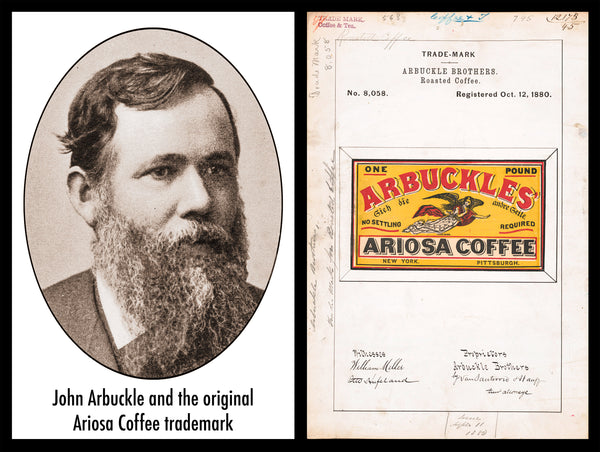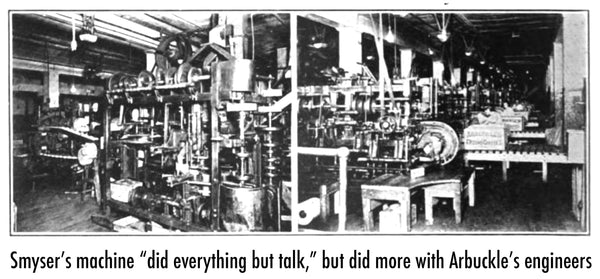What is an Arbuckle? Well, there’s more than one Arbuckle, so the question should be “What are Arbuckles?”. It’s important because Arbuckles Ariosa Coffee becoming the coffee that "won the west" was a joint effort between 2 brothers from Pittsburgh - merging quality management and forward-thinking production to grow a single roasting station into the most sold coffee in U.S. history.
Great Scots
In 1859, the young son of Scottish Immigrants named Charles Arbuckle goes into grocery wholesale business with his uncle Duncan McDonald, and William Roseburg under the name “McDonald and Arbuckle.” Charles’ older brother, John, had finished his schooling in Allegheny County (Pittsburgh area) and was in college when he drops out and joins the firm in 1860. Within a few years, and a few retirements, “McDonald & Arbuckles” became “Arbuckles & Co.” with brothers John and Charles leading the new company by 1864.
While Charles didn't have as much schooling as his older brother, he was a master businessman and shrewd negotiator. With the executive side in good hands, John Arbuckle took a special interest in the coffee department. Even though the first wholesale coffee-roasting plant in the U.S. had been operating since 1790, Americans still largely purchased green coffee and would roast it at home. The 2 major problems for the end-user coffee drinker were inconsistent roasting and mildew/mold/decomposing beans at the bottom of the container even after being roasted.
In 1865, John created a glazing solution made of Irish moss, gelatin, isinglass, sugar, and eggs to coat roasted beans after they’d been cooled. Did it lock in the coffee flavor and keep moisture out? Indeed it did, and in 1868, John patented his glazing. It was so successful, the brothers moved to Brooklyn, New York to expand. To control the sugar supply, John opened up his own sugar refinery, eventually starting a war, which he won. Others were fast to find their own method of coating beans, including a starch and gum-Arabic mixture by John T Cook in 1872.
The Cowboy Coffee
It was the crossroads of 3 innovations with Arbuckle’s Ariosa coffee that made it the preferred coffee for wranglers whose home was 'on the range.’ First, coating the individual beans to lock out moisture worked better than any packaging available, and it'll be another 30 years (1898) before Rockton, Illinois' own Edwin Norton introduces the world to vacuum-packing. The second innovation had John breaking with tradition in the mid-1860s by packaging coffee in 1 pound paper packed bricks. Even though it was laughed at by contemporaries, as paper packing was mainly used for foods like peanuts, the coating around the beans did all the work. Easy to store, compact packaging, and with extended time to grind the coffee pushed the Ariosa brand to the most remote areas possible, and would still taste like it would fresh from the grocer's.
Third was the fun marketing. Arbuckle included coupons for everything from razors to wedding rings. He had trading cards, and mini-maps in beautiful colors. Each package contained a stick of peppermint candy. And let’s be honest, free candy is a great idea to cowboys out on the range for weeks at a time. When the chuck wagons got coffee to the fields, whomever ground the coffee got the candy.
Arbuckle’s dominated the cowboy market, and by 1879, it was necessary to increase automation to keep up with demand. Henry Smyser of Philadelphia and John finally created the all-in-one manufacturing machine that creates the container made of glassine parchment, fills it, packs it, seals it, and spits it out. 10 sets were dedicated to Arbuckle Ground coffee, and 12 sets were dedicated to Ariosa bean in their Brooklyn factory.
A Brew New Era
Charles Arbuckle died in 1891 after the embarrassing revelations of his letters to a Clara Campbell. She took him to court for breach of contract. He had promised to marry her - but then changed his mind while she was out of the country. Clara won, which Charles handled with expected maturity. John died in 1912, but the company stayed in the Arbuckle family’s hands until 1929. By 1935, what was left of the company had been mismanaged, and merged with Maxwell House, then later General Foods. Arbuckle’s Yuban brand coffee was the only brand that survived.
Email Subscribers: Use Code W22J For 20% Off This Weeks Select Items
Fortunately for the Arbuckle name and Arisoa's original recipe that’s not where the story ends. In 1974, a large-hearted couple named Pat and Denney Willis from Tuscan, AZ purchased expired food trademark of the flying angel logo for Arbuckle Coffee, recreated the process, and a new family has continued the legacy.














Leave a comment